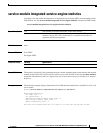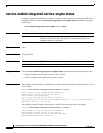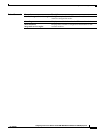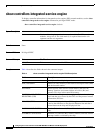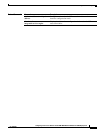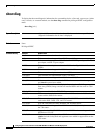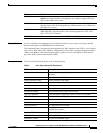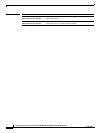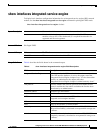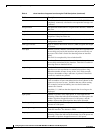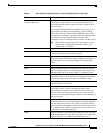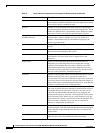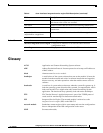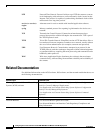
36
Configuring Cisco Access Routers and the NME-WAE Network Module for ACNS Deployments
OL-13140-02
show interfaces integrated-service-engine
overrun Number of times that the receiver hardware was unable to handle
received data to a hardware buffer because the input rate exceeded
the receiver’s ability to handle the data.
ignored Number of received packets that were ignored by the interface
because the interface hardware ran low on internal buffers. These
buffers are different from system buffer space. Broadcast storms
and bursts of noise can cause the ignored count to increase.
input packets with dribble
condition detected
Number of packets with a dribble condition. Dribble bit error
indicates that a frame is slightly too long. This frame error
counter is incremented only for informational purposes; the
router accepts the frame.
packets output Total number of messages that have been transmitted by the
system.
bytes Total number of bytes, including data and MAC encapsulations,
that have been transmitted by the system.
underruns Number of times that the transmitter has run faster than the router
could handle. This error may never be reported on some
interfaces.
output errors Sum of all errors that prevented the final transmission of
datagrams out of the integrated service engine that is being
examined. This number may not balance with the sum of the
enumerated output errors, because some datagrams may have
more than one error, and others may have errors that do not fall
into any of the specifically tabulated categories.
collisions Number of messages that have been retransmitted because of an
Ethernet collision. This error is usually the result of an
overextended LAN (such as an Ethernet or transceiver cable that
is too long, there are more than two repeaters between stations, or
there are too many cascaded multiport transceivers). A packet that
collides is counted only once in output packets.
interface resets Number of times that an interface has been completely reset. This
can occur if packets that were queued for transmission were not
sent within several seconds. On a serial line, this error can be
caused by a malfunctioning modem that is not supplying the
transmit clock signal or caused by a cable problem. If the system
notices that the carrier detect line of a serial interface is up, but
the line protocol is down, it periodically resets the interface in an
effort to restart it. Interface resets can also occur when an
interface is looped back or shut down.
babbles Count of frames that are greater than 1518 bytes and that have
been transmitted. This error indicates that the transmitter has been
on the interface longer than the time necessary to transmit the
largest frame.
late collision Number of late collisions. A collision becomes a late collision
when it occurs after the preamble has been transmitted.
Table 6 show interfaces integrated-service-engine Field Descriptions (continued)
Field Description



